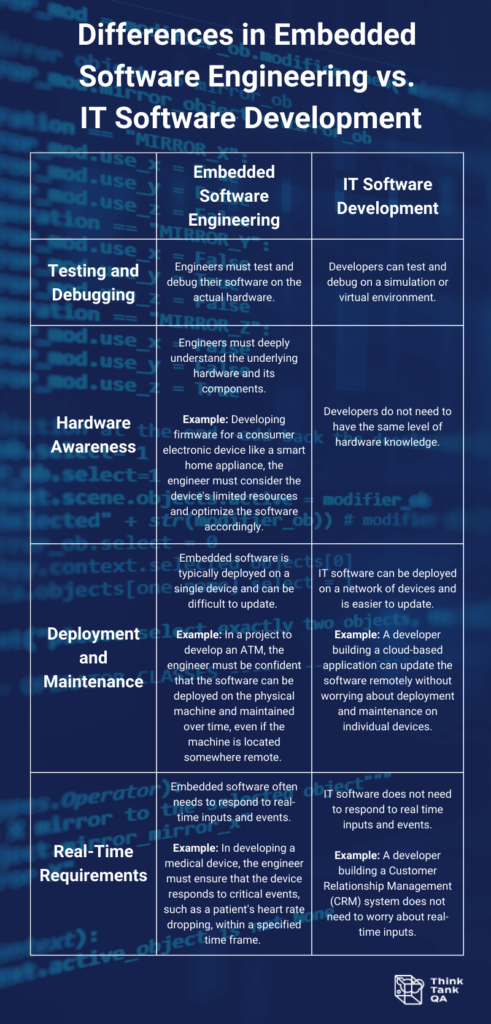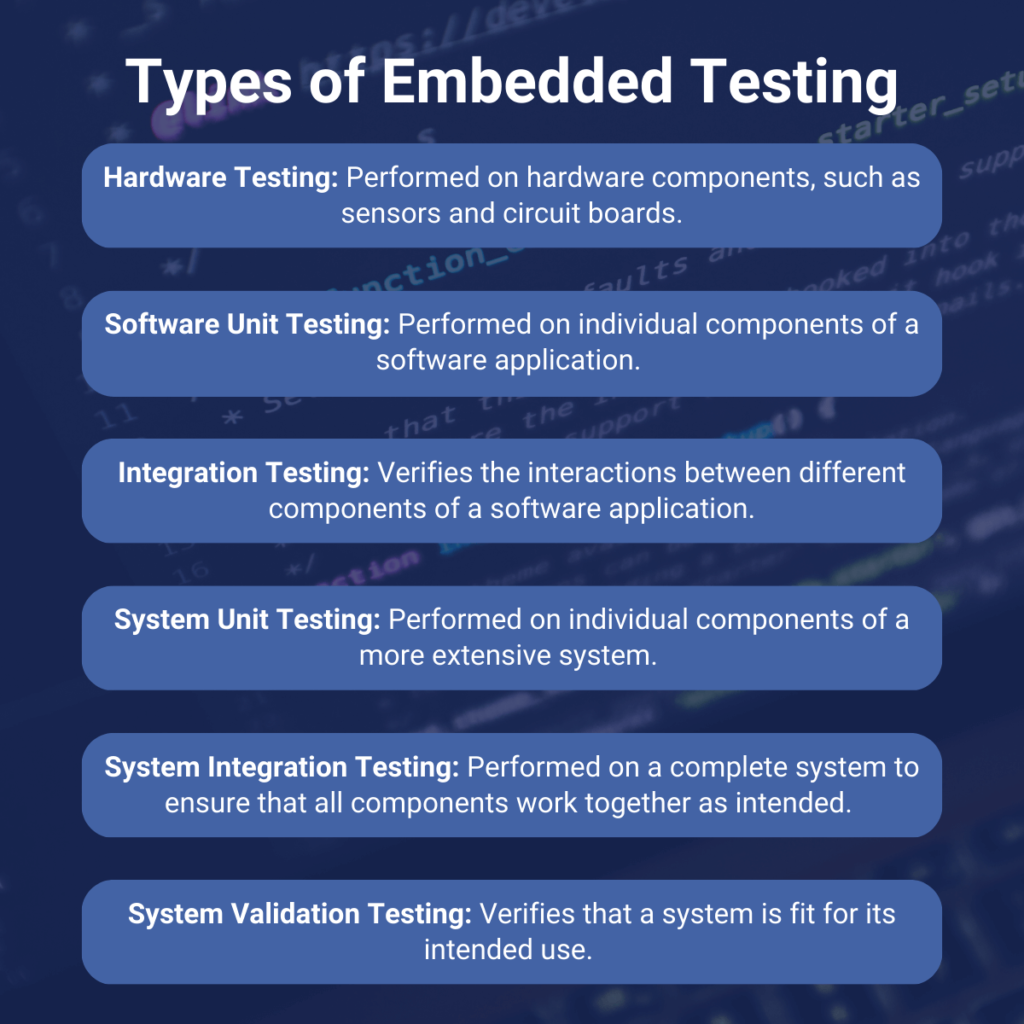Embedded testing is used countless times in items we interact with every day. It’s a crucial aspect of software development, ensuring that software runs as intended and integrates seamlessly with hardware systems such as medical devices, automobiles, and electronics.
In this blog article, we will dive into the world of embedded software testing, including its various types and the challenges that come with it. So get ready to gain a deeper understanding of this critical aspect of software development!
- What Does Embedded Testing Mean?
- Why You Should Complete Embedded System Testing
- Types of Embedded Testing
- When to Start and Stop Embedded System Testing
- Challenges of Embedded Testing
- Take Control of Your Embedded System Requirements
Leverage Think Tank QA’s engineers for smarter testing and better software design.
What Does Embedded Testing Mean?
Embedded testing is the testing of software in hardware systems to guarantee optimal performance and efficiency. The main goal of embedded testing is to ensure the software runs without a hitch and meets all the requirements set for the system. It’s an excellent approach to guarantee security in hardware systems such as medical equipment, railways, automobiles, electronics, and aviation.
Several types of tests fall under the umbrella of embedded software testing, including unit, integration, and validation. Software engineers and quality assurance specialists carry out these tests though some can be automated. However, the specific types of tests and processes will depend on the hardware and software being tested, and the project’s goals and requirements.

Why You Should Complete Embedded System Testing
Embedded system testing is an important step in developing any product that contains embedded systems or software. It’s like a quality check before the final product is released.
By doing this testing, you can make sure your system is reliable, performs well, and is secure from any potential threats. In other words, it helps you avoid unpleasant surprises down the line, ensuring a successful product launch. The following are some of the reasons why embedded system test matters:
- Find bugs
- Reduce risks to employees and the company
- Reduce costs
- Improve performance before release
- Ensures the system’s security
Find Bugs
Bugs can start as minor problems but, if left in a system, can grow and expand over time and have serious consequences. For example, a bug that causes a system to crash may be related to a memory leak, which can get worse over time and cause the system to crash more frequently. Additionally, bugs can interact with other bugs, making problems more difficult to diagnose and fix.
However, testing embedded software can identify and eliminate these bugs early in the development cycle, which is more cost-effective and less time-consuming than finding bugs later in the process.
Reduce Risks to Employees and the Company
Think about it from a software and security perspective. Bugs and vulnerabilities in the system can cause it to crash or malfunction, putting employees’ work at risk and potentially compromising sensitive information. In a worst-case scenario, it can lead to data breaches and cyber attacks, which can have devastating consequences for the organization and its employees.
Additionally, when a system fails, employees may have to spend extra time and resources fixing it, which can reduce their productivity and efficiency. If these problems are unresolved when released, the company’s reputation is also put at risk. Customers can lose trust in the company and their products.
Performing system-level testing, companies can ensure that their system is working perfectly and prevent problems that could damage their reputation.
Reduce Costs
Failing to test a system and address problems on time can lead to a backlog of issues that can be difficult to fix. It’s like a snowball effect – the longer you wait, the harder it gets to fix. This also increases the costs and time associated with fixing the problem and slows progress on other projects. However, by addressing problems early on, you can save time, and resources to keep your projects running smoothly.
Improve Performance Before Release
Embedded systems testing helps companies validate their systems. It ensures that the systems are optimized and perform at their best before release.
By conducting embedded testing, companies can identify and fix performance issues early on, improving the overall quality of the product. It can also help catch any potential performance bottlenecks that could slow down the system or cause it to crash, ensuring that the product is stable and ready for release. This can lead to a faster, more reliable system that meets customer expectations and provides a better user experience.
Ensures the System’s Security
Embedded testing ensures a system’s security by thoroughly checking for potential vulnerabilities and threats. If any vulnerabilities are detected, security measures will be implemented, preventing unauthorized access to the system. These tests can include checks for weak points, such as buffer overflows or SQL injections. Embedded testing also helps companies comply with security regulations, such as PCI DSS or HIPAA.
Types of Embedded Testing

Partner with Think Tank QA for hands-on test design, support, and execution in all of your software design needs.
Embedded Hardware Testing
Embedded hardware testing focuses on the hardware components of a system, such as microcontrollers, sensors, and circuit boards. This testing aims to catch any hardware issues before they become more complex, while ensuring the durability and reliability of the system.
Embedded hardware testing involves running various tests, such as functional tests to check if a sensor correctly detects changes in temperature, stress tests to see how it handles extreme conditions, and reliability tests to ensure it is durable.
Software Unit Testing
Software unit testing is all about checking individual software units, like functions, classes, or modules. Developers usually write test cases to check each code unit and then run those tests automatically.
The reason for performing embedded software unit testing is to detect any problems early before they turn into complex issues. This way, you can quickly fix them, saving time and resources.
Integration Testing
Integration testing is all about checking how different software parts work together to produce the desired results. After each part of the software has been tested individually, the software is put together into a larger system and tested as a whole, ensuring the software components communicate with each other and produce the desired results.
Integration testing helps to detect issues related to communication and coordination between modules, data transfer, and interface compatibility.
System Unit Testing
System unit testing is all about testing each part of a system to ensure it works perfectly. Developers and embed testers write test cases using code to check different scenarios for each part of the system and then run those tests—the goal is to detect problems with each part before they become complex issues in the larger system.
Though it seems similar to integration testing, think of system unit testing as checking each individual puzzle piece before putting the puzzle together. Integration testing is making sure all the puzzle pieces are put together and fit correctly.
System Integration Testing
System integration testing verifies that the complete system, including all its components and interfaces, works together. This testing is performed after integration testing and focuses on ensuring the system integrates with other systems and meets the overall requirements.
System integration testing helps to identify and resolve issues related to the integration of the system with other systems and the end-to-end functionality of the system.
System Validation Testing
System validation testing confirms a system meets the specified requirements and is ready for deployment. The tests are designed to cover all the functional and non-functional requirements, such as performance, security, and usability. The results of the tests are then compared to the expected results to determine if the system is ready.
This test aims to validate the system’s ability to perform well in real-world scenarios, and is usually conducted toward the end of the software development process.
Find support through every stage of software product design with Think Tank QA.
When to Start and Stop Embedded System Testing
The frequency of embedded testing depends on the development process and the complexity of the system.
Factors to consider when running embed testing:
- The type of testing needed.
- The available resources.
- Amount of time you have.
Generally, it is necessary to balance thorough testing and efficient development.
When to Start Embedded Testing
The earlier, the better! Starting embedded testing early in the development process is necessary for detecting any issues and fixing them before they become complex. By starting embedded testing early, you can notice and fix bugs quickly and increase the chances of delivering a high-quality product on time.
When to Stop Embedded Testing
Deciding when to end testing can be a tough call. It’s a constant process, and it’s difficult to guarantee 100% testing. To assess risk, you can look at things like risk analysis or, for smaller projects, the number of test cycles, high-priority bugs, and test coverage.
Embedded Automation
Embedded automation is a handy tool for repetitive testing and helps minimize time and human error. It starts when test cases are ready to be automated and stops when all planned cases are done or the desired quality criteria are met. One example of its use is in the automotive industry for testing brakes and accelerator response.

Think Tank QA Engineers are ready to help you plan and implement embedded testing.
Challenges of Embedded Testing
There are a few different challenges of embedded testing that must be considered when deciding when and what type of test to complete.
Hardware Dependencies
This means multiple hardware components must work together for proper functioning, making testing challenging. The severity can vary, causing major problems if components do not interact well or minor issues if they do. It’s a common problem in embedded systems and can frequently occur with hardware updates or changes. For example, testing a display alone will not show interaction issues between it and a GPS module in an automotive system.
Software Updates
This refers to updating the software in an embedded system. It can be challenging because embedded systems often have limited resources, causing performance degradation if updates are not properly accommodated. This is a common issue and can frequently happen, especially with systems requiring new features or bug fixes. For example, updating a home automation system with a processor, memory, and wireless communication module to include new features may cause compatibility issues and system instability.
Scope of Automation
This refers to how much of the testing process can be automated. It can be challenging, and the severity of this challenge can vary, as some tests may be easily automated while others may not. For example, a medical device that includes a sensor, a processor, and a display. Automating the testing of the display may be straightforward, but that of the sensor may require specialized hardware and expertise
Use of Open Source Software
This means that the software is publicly available and free to use. The severity of this challenge can vary, and it is a common issue that can frequently happen with the growing popularity of open-source software in embedded systems. For example, consider a smart home device with an open-source operating system. The smart home device may be vulnerable to hacking and other security threats if the operating system contains vulnerabilities.
Repeatable Defects in Hardware and Software
This refers to recurring problems in the embedded hardware and embedded software of a system. This can be severe because it causes the system to malfunction or become unreliable. It is a common issue that frequently occurs, especially if proper testing and quality assurance processes are not in place.
For example, consider a wearable device with a processor, memory, and sensor. If the sensor produces inconsistent data, it may be difficult to determine if the issue is due to hardware or software defects.
Let Think Tank QA Take Control of Your Embedded System Testing Requirements
Embedded testing is a crucial step in ensuring the quality and reliability of embedded systems. It is different from IT software development and requires specialized knowledge and tools.
If you want to ensure the success and reliability of your embedded system, it’s essential to have a team of quality control experts on your side. With Think Tank QA, you’ll have a team of experienced quality engineers with the expertise and skills needed to tackle the unique challenges of embedded system testing.
With their ability to ask questions from perspectives others can’t and to spot inconsistencies, potential user-level issues, and errors in design, they’ll help you identify and resolve issues before they become problems. To ensure the quality of your embedded system, let Think Tank QA take control of your embedded testing requirements.

